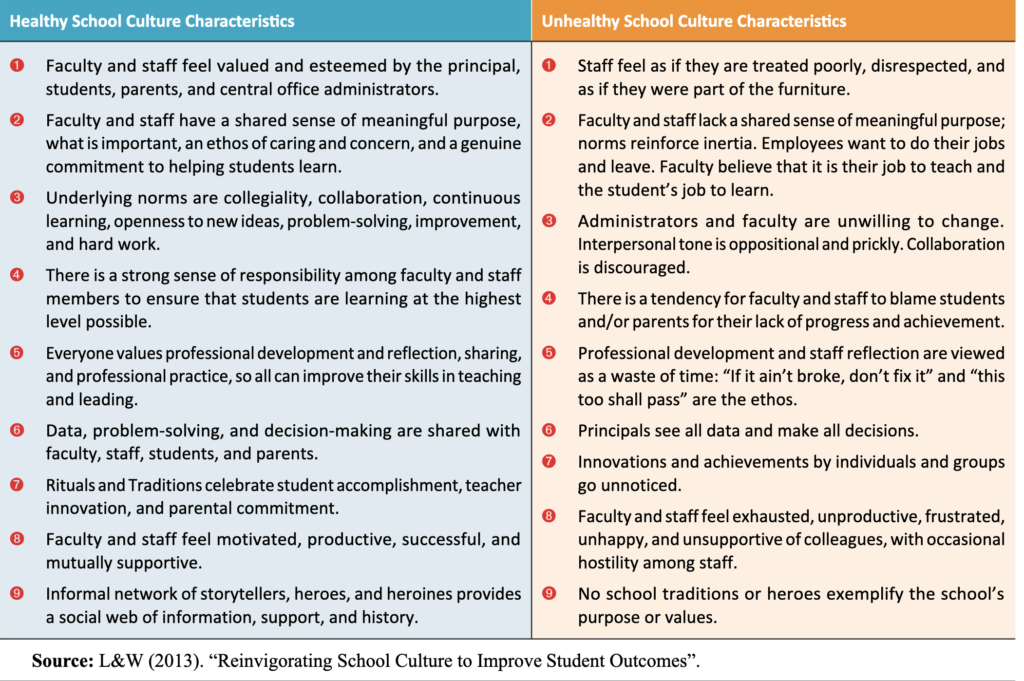The link between school culture and student achievement
By Samar Al-Majaideh
May/June 2023

The term “school culture” can be used to explain how a school forms norms and values and how they impact teachers and students. Culture influences every part of the school day, from what faculty members talk about during their break time to the instruction strategies promoted.
Schools are complex and diverse systems, partly because they’re made up of interconnected components. In other words, a change in one component will cause changes in other areas (L. S. Kaplan & W. A. Owing, “Reinvigorating School Culture to Improve Student Outcomes,” 2013). Among the many factors contributing to school culture are the dynamic interactions among students, faculty, administrators and parents. In addition, the dynamics can be seen in both public and private schools.
Islamic school leaders must gain a deeper insight into this culture if they want to effectively manage and impact it. For example, researchers Mukhtar and Ali’s study at the State Islamic Senior High School in Indonesia’s Jambi province found that school leaders and culture were important factors for teacher satisfaction.
There are two types of school cultures: healthy and unhealthy. Educational leaders should seek ways to heal the latter, and those who understand school culture (e.g., its values, expectations, assumptions and vision) to bring about cultural changes that increase teachers’ retention, job satisfaction and attendance.
A school’s main responsibility is to foster a learning environment for its students. Developing a strong culture, one that promotes rigorous academic standards, competent leadership and cooperative teacher–staff relationships, are key factors that contribute to student outcomes. When students and teachers work in a healthy and positive environment, classrooms can be transformed into places where students are naturally motivated to learn.
Healthy schools accomplish their objectives and instill shared principles and camaraderie among teacher workgroups. Strong school cultures are characterized by deeply held and widely shared core values. In general, those who contribute to it are more likely to commit to its core values if they share a common understanding of them. This builds unity of purpose, organizational commitment, loyalty and cohesiveness. On the other hand, if academic achievement is not highly valued in low-performing schools, students and teachers will lack the motivation to improve.
Evaluate Your School Culture: Two Assessment Tools
As technology helped educational practices evolve, researchers have developed a variety of school cultures and climate instruments to gain insight into what needs to be improved to affect student outcomes positively. Such instruments include the organizational health inventory and the school culture triage survey.
Developed by Dr. Wayne K. Hoy, the Organizational Health Inventory has 37 questions for the elementary survey and 44 questions for the secondary survey. The five dimensions of school health for elementary schools are academic emphasis, collegial leadership, institutional integrity, resource influence and teacher affiliation. The seven aspects of school health for secondary schools are academic emphasis, consideration, institutional integrity, initiating structure, staff morale, principal influence and resource support (W. Hoy, J. C. Tarter & B. Kottkamp, “Open School/Healthy Schools,” 1991).
The School Culture Triage Survey assessment tool, created by C. R. Wagner (“The School Leader’s Tool for Assessing and Improving School Culture,” 2006), measures the degree to which the following three cultural characteristics are present: (1) professional collaboration (whether teachers and staff collaborate to find solutions that will improve organizational and instructional issues), (2) affiliative and collegial relationships (how well staff and teachers support one another and enjoy working together) and (3) efficacy or self-determination (examines the school members’ motivation to grow and improve their professional skills).
Good school cultures are created by maintaining the community’s commitment, teacher effectiveness and parental and student support. Muslim educators especially are responsible for trying to foster a positive culture so that students, faculty and other stakeholders can work together to accomplish shared goals. Building healthy cultures requires infusing Islamic manners and morals into daily practices and building positive relationships among school members.
Healing the school culture is important, for our community faces numerous challenges, and educational reform is an essential part of communal responsibility. To expand, healthy school cultures can drive educational reform initiatives and connect educators with the community, which can provide access to much-needed support and resources. Numerous studies have confirmed that the school culture must support educational reform at struggling schools so that change can happen (T. E. Deal & K. D. Peterson, “Shaping School Culture,” 1999). Our schools’ cultures can be healed by examining the relationships among students, parents and the community. Students’ achievement will only improve when our schools have positive and supportive cultures.
The table below displays the characteristics of healthy and unhealthy school cultures.

Dr. Samar Al-Majaideh is research project manager, Islamic Schools League of America.
Resources
Wagner, C. R. (2006). The School Leader’s Tool for Assessing and Improving School Culture.
Tell us what you thought by joining our Facebook community. You can also send comments and story pitches to horizons@isna.net. Islamic Horizons does not publish unsolicited material.
